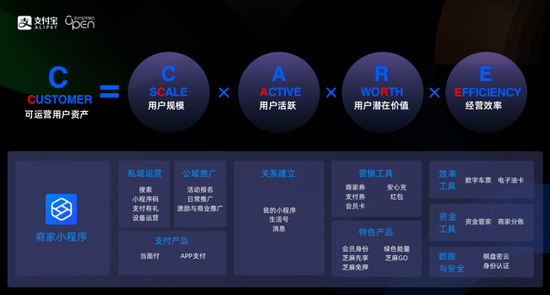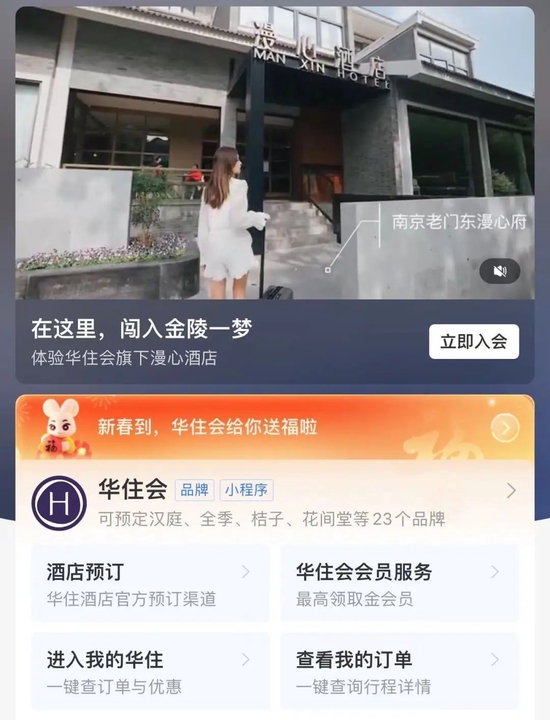
With the accelerated deployment of Douyin, the competition for small programs is evolving from WeChat and Alipay’s “Errenzhuan” to “Three Kingdoms”.
At the end of last month, Douyin opened up the mini-programs for transportation and travel, and T3 travel was the first batch to enter. Earlier, Ele.me also reached a cooperation with Douyin around small programs. Ele.me and T3 travel respectively cut in from the two high-frequency scenarios of “eating” and “traveling”, which are expected to bring a boost to the Douyin applet.
WeChat and Alipay were the main players of mini-programs before Douyin was added. According to data released by the research company QuestMobile at the end of last month, the scale of de-duplicated active users of WeChat and Alipay applets in 2022 will be 921 million and 668 million respectively, leading other platforms.
Previously, the vast majority of merchants put the main positions of small programs on WeChat and Alipay. Now, with the entry of Douyin, merchants have more choices in making small programs. However, it is impossible for merchants to exert equal efforts on the three large and small program platforms. They need to find the most suitable platform for themselves and use their resources wisely.
An ideal small program ecology should establish an efficient public-private domain traffic model, allowing traffic to flow smoothly between the public domain and the private domain, and depositing it in the merchant’s private domain, providing a basis for long-term user operations; at the same time, it not only provides the foundation In addition to functions, it is also necessary to have the ability to integrate the characteristics of the entire platform and precise scenarios, and upgrade from an operation tool to a business assistant.
This new demand beyond the basic functions of small programs heralds the arrival of the “small program +” era.
At present, WeChat, Alipay, and Douyin mini programs each have their own strengths. The main difference lies in the distribution mechanism of platform traffic, as well as the way and ability to support the growth of businesses. This deep-seated difference derived from genes will shape the basic competitive situation of the three major platforms in the era of “mini-program +”, and will clarify the direction for the next step of the mini-program.
In January 2017, starting from WeChat, Alipay, Baidu, Douyin, etc. entered the game one after another to kick off the prelude to mini programs. According to statistics from Aladdin, a small program data platform, in the first half of 2022, there will be more than 7.5 million small programs on the entire network, with a total of over 780 million DAU (daily active users).
Merchants deploy small programs, first of all, they value platform traffic. The small programs of the three major platforms are backed by billions of traffic pools, covering different levels of netizens, and are extremely attractive to merchants. But for how to distribute traffic, WeChat, Douyin and Alipay have different philosophies.
WeChat mini-programs have always focused on private domain operations. After a merchant opens a mini-program, it needs to find traffic through different channels, such as mounting the mini-program entrance in content scenarios such as official accounts and video accounts, or optimizing for on-site tools such as search and geographic location.
WeChat has also opened a few public domain entrances for Mini Programs, such as the “Recently Used Mini Programs” drop-down on the home page, and the Mini Program summary page on the discovery page. However, most of these portals are for reuse scenarios; if merchants need to promote new applets, they still have to drain traffic by themselves.

Contrary to WeChat, the Douyin mini-program is characterized by obvious centralization, and the platform has a greater right to speak. Whether the merchant’s mini-program is doing well or not, in addition to its own quality, it is often necessary to consider the support of Douyin.
As a model that Douyin is trying to create, Ele.me will enter the Douyin applet in early 2020. But at that time, users could only enter through search, and the cooperation effect was mediocre; Meituan, which entered at the same time, left early. It wasn’t until the second half of 2022 that Douyin was looking for local life allies, and the Ele.me mini program ushered in a turning point. The cooperation between the two parties began to land in Nanjing and other cities one after another.
Alipay has gone through two stages. When it was first launched in 2018, Alipay proposed a traffic distribution model combining “centralization + decentralization”. However, due to the relatively high proportion of Ali-based mini-programs at that time and the high-quality traffic of the Alipay APP, this model actually caused the traffic to be tilted towards “insiders” and indirectly dragged down third-party merchants.
By 2021, the Alipay Mini Program will release a signal of complete liberalization and upgrade to “decentralization as the main + centralization as the supplement”: the platform will try its best to guide public domain traffic to merchants’ private domains and keep them there; merchant mini programs will gradually Occupy the C position in the Alipay ecosystem.
Under the guidance of the new strategy, the issue of “don’t let the fat and water flow to outsiders” was the first thing to be attacked: in May of that year, Alipay moved “My Mini Program” to the Jiugong grid on the home page, and users can edit it by themselves; two months later, it opened again. With the custom function of Jiugongge, platform services no longer have a fixed position, and are on an equal footing with merchant applets.
This strategy of working from the public domain to the private domain will be further strengthened in 2022. Alipay APP opened more public domain traffic entrances, including switching the center tab at the bottom of the homepage from “Word of Mouth” to the “Life Channel” that aggregates merchants’ life accounts, giving more exposure to those applets that have not yet been discovered by users.
In addition, Alipay is still encouraging merchants to operate independently with traffic subsidies. According to the Fanxing Project 2.0 in May last year, merchants guide users to access mini programs through various self-operating actions, and can obtain public domain traffic incentives to magnify business results. According to the latest data disclosed in the “2022 Alipay Powered Entity Annual Report”, the plan has opened up nearly 20 billion free traffic, bringing an average of 1 million users to a single merchant’s mini-program every day, and the merchant can save 200,000 yuan in marketing expenses every year.
On the whole, whether it is centralized, decentralized or a combination of the two, the small program traffic distribution models of the three major platforms are all based on their own genes, and there is no absolute advantage or disadvantage. However, the superimposition of different traffic models and platform features makes their mini-program ecology look different.
WeChat Mini Programs are backed by the WeChat social relationship chain, which is especially suitable for entertainment content and games based on social fission. The typical representative of the former is the popular mini-game “Sheep a Sheep” last September; the representative of the latter is Pinduoduo. Before being banned by WeChat, various “cut a knife” mini-programs were linked in the WeChat group The crazy rumors made Pinduoduo get a lot of free traffic.
In this week’s 2023 WeChat public class, relevant people from WeChat specifically mentioned that the size of the small game group has continued to expand in the past year, with the per capita active time increasing by 24% year-on-year, and the number of activations per capita increasing by 20% year-on-year; the coverage area has also achieved second- and third-tier cities It is 50-50 open with cities below the third tier. This also proves from the side that WeChat Mini Programs are highly compatible with pan-entertainment content and gameplay.
Douyin’s long-term ability is based on the recommendation algorithm’s ability to manufacture popular models. This time, Douyin did not quickly cover all industries, but introduced leading merchants such as Ele.me and gave them all-round support. This is highly similar to Douyin’s idea of mass-producing top streams of live broadcasts, and the superior algorithm and traffic pool are enough for the Douyin applet to replicate this path.
The Alipay mini-program is backed by transaction flow, and has an advantage in terms of operating threshold and conversion efficiency.
From the perspective of traffic attributes, WeChat is social + content, Douyin is content + e-commerce, and only Alipay is relatively pure transactional traffic. Alipay does not do social networking, but the content ecological construction with the life account as the main body has been quite effective. However, Alipay did not attack its strengths, but opened up as much traffic, resources and capabilities as possible to lower the threshold for merchants to operate.
The “2022 Alipay Zhushi Annual Report” shows that 101 general platform products and 1,809 API interfaces will be opened a year; nearly 20 billion free traffic will be opened. Therefore, merchants are very enthusiastic about digitalization: in 2022, the number of merchants integrating Alipay digital products will increase by 3 million, and the usage of products will increase by 53 times year-on-year.
In addition, the Alipay mini program can also mobilize the product functions and scene ecology of the Alipay system, such as Jiwufu marketing IP, member channels, Sesame Credit, Ant Forest, etc. By accessing these capabilities, merchants can facilitate transactions more efficiently, retain users, and make the self-operation link smoother.

In addition to the different traffic strategies and ecological appearances, WeChat, Douyin and Alipay also imply subtle differences in strategic mentality when facing mini programs.
Among the three major platforms, the star product of WeChat is the video account, which is also the “hope of the audience” hand-picked by Ma Huateng. In the WeChat public class in the past two years, the video account has already become the absolute C position, while the mini program is increasingly in a subordinate position. What’s more, there are many users of WeChat mini-programs and their status is stable. For the time being, there is no need for drastic reforms. This also makes the WeChat mini-program a bit Buddhist, ubiquitous but not in the center of the stage.
Although Douyin calls the mini program “the main carrier of the open platform”, in its strategic sequence, even the open platform is not the first array. Douyin’s popular fried chicken is undoubtedly a live broadcast e-commerce, and the shelf e-commerce will also receive full support in 2022; the local life sector ranks second and is currently accelerating. Small programs are important, but they are not the lifeline of Douyin.
In contrast, Alipay is the most determined to invest in small programs. Its payment sector has entered a mature stage, while the service sector must be undertaken by small programs. Whether it can do well will largely determine the growth boundary of Alipay. Compared with the other two rivals, Alipay is more willing to invest resources and energy, and try its best to expand opening up and support, so that merchants’ small programs can operate better.
On the whole, WeChat, Douyin, and Alipay mini-programs each have their strengths and weaknesses, but the first two are not the absolute core of Tencent and Douyin Group, and naturally they do not have the fighting posture of an All in mini-program. If Alipay wants to make a difference beyond payment, the mini program is currently the most reliable path. Now it is more determined to catch up and fight to the death, and merchants can get more “slow dividends”.
Merchants pan for gold from the public domain of the platform and settle in the private domain. In addition to caring about the scale of traffic and whether it can be retained, they also pay special attention to whether the threshold for public and private domain operations is approachable enough to attract traffic, retain and transform it.
A low-threshold mini-program public-private domain operation model not only includes lower traffic costs, merchants do not need to invest more money; it also includes higher traffic conversion efficiency, and public domain users can settle into private domains instead of flooding, The water passed without a trace.
The strategy of many merchants is to make full use of social fission to divert traffic from the public and private domains within the scope allowed by the platform rules. The leader of this gameplay is undoubtedly the WeChat mini-game “Sheep a Sheep”. It uses the exquisite design of insight into human nature, combined with the social network of WeChat acquaintances, set off a storm in WeChat groups and Moments, and broke the circle to station B, small Platforms such as Red Book eventually became phenomenal hot mini programs.
However, the myth of “A Sheep and a Sheep” is really rare, and the last one that caused such a sensation dates back to “Synthetic Watermelon” two years ago. The latter has now returned to plain after the highlight. This also reflects that no matter how large the traffic is, if it cannot be settled in the private domain, the long-term survival of the small program is still worrying.
Some merchants have accumulated a lot of experience. Jikrypton Subscription is a car subscription service provider. It was launched in June last year, and its main business positions are in APP and Alipay applets. On the Alipay platform, it attracts new customers from public domain traffic pools such as consumer coupons and life channels. It completes the cold start in half a year, and often sells out during popular periods such as the Spring Festival.
Ma Kun, head of Jikrypton Subscription Operations, believes that making an Alipay applet is equivalent to playing “World of Warcraft”, and all “resources” can be obtained through self-operation; while on other platforms, merchants need to spend money to buy traffic, which is equivalent to “krypton gold” .
On the other hand, the more accurate the public domain traffic of the platform and the higher the degree of overlap with the potential customer base of the merchant, the greater the chances of users completing consumption and retaining it. This is equivalent to lowering the traffic demand of merchants and realizing cost reduction and efficiency increase in the marketing process.
Taking the wine and travel industry as an example, Huazhu Group established a membership system “Huazhu Club” very early, and now has 190 million members. To further expand its membership, Huazhu needs to find more high-value users.
In Huazhu’s view, the user portraits of Alipay members match it and gather in vertical scenes such as member channels. It launched the Alipay mini-program in 2019. In the next few years, based on the Alipay applet, Huazhu opened up the membership system and “Jiwufu” IP cooperation to attract new customers. In June last year, He Liu, vice president of Huazhu’s strategic cooperation and platform operations, said at an industry event that the Alipay mini-program has become the fastest-growing channel for Huazhu Group’s order volume. Nearly half came from Alipay.

More merchants are still groping for their own small program methodology. With the significant loosening of epidemic prevention and control measures, 2023 is a key period of opportunity for large and small businesses to bottom out and rebound. How to make good use of small programs to grasp “retaliatory consumption” at a lower cost and with higher efficiency is a common concern of merchants.
In response to this problem, in addition to personally giving guidance, the three major platforms are also building a third-party service provider system, allowing professional organizations to help merchants operate small programs on their behalf, and complete key actions such as drainage, conversion, and precipitation in a more convenient way.
The value of service providers has emerged. According to Tencent’s financial report, the GMV of WeChat Mini Programs has achieved growth of over 100% in both 2020 and 2021; Alipay also opened up the traffic generation operation capability for service providers last year. According to the annual report of Alipay Zhushi, in the past year, it has cooperated with service providers to create more than 400 industry solutions, helping some technical service providers to earn 500,000 more than the previous year.
However, the merchants that service providers can cover are limited after all, and most merchants still need to operate on their own. Using small programs as the operating base, with the help of platform traffic, characteristic capabilities and precise scenarios, users in the public domain are deposited into private domains for transformation and retention and long-term operations. solution.
For WeChat, Douyin and Alipay, “Mini Programs +” means opening up more traffic, providing more capabilities, and opening up more scenarios. In addition to the increase in players, the small program “Three Kingdoms Kill” has also evolved from a function and traffic to a broader map, and the competition between products and traffic has been replaced by a full ecological competition. At present, the volume of WeChat’s mini-programs tends to be saturated, and platform dividends are beginning to tilt towards video accounts; Douyin’s mini-programs have just started, and solutions are still being explored for how to make traffic available for merchants’ private domains; The mechanism tends to be smooth, and the threshold for self-operation of merchants is also lower. In addition, there are still dividends in platform traffic, which has become the choice to get started as soon as possible. As for the platforms, how to maximize their strengths and circumvent weaknesses, and give full play to the unique advantages of the entire system will determine the positions of the three major platforms in the “mini program +” era pattern, and form different attractions for thousands of merchants.

(Disclaimer: This article only represents the author’s point of view, not the position of Sina.com.)
This article is reproduced from: https://finance.sina.com.cn/tech/csj/2023-01-12/doc-imxzxhuk2242724.shtml
This site is only for collection, and the copyright belongs to the original author.